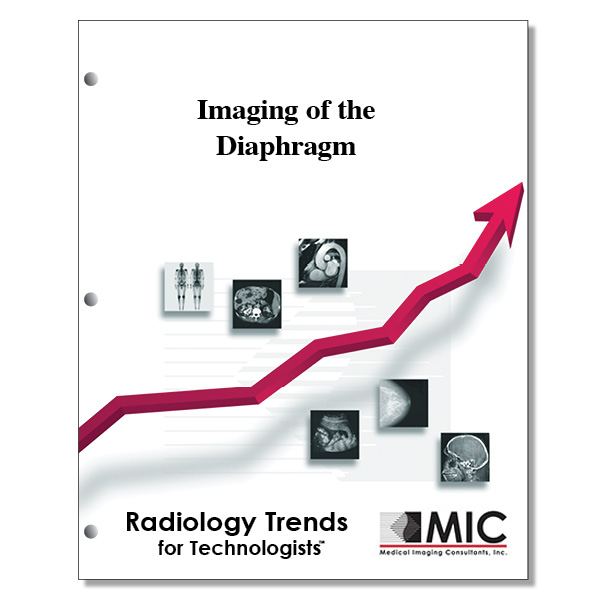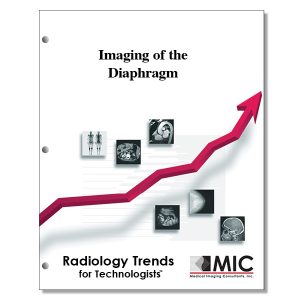

Imaging of the Diaphragm
The role of functional imaging with fluoroscopy to diagnose diaphragmatic dysfunction is presented.
Course ID: Q00353 Category: Radiology Trends for Technologists Modalities: CT, Radiography, Vascular Interventional3.25 |
Satisfaction Guarantee |
$34.00
- Targeted CE
- Outline
- Objectives
Targeted CE per ARRT’s Discipline, Category, and Subcategory classification:
[Note: Discipline-specific Targeted CE credits may be less than the total Category A credits approved for this course.]
Computed Tomography: 2.25
Procedures: 2.25
Neck and Chest: 2.25
Magnetic Resonance Imaging: 2.25
Procedures: 2.25
Body: 2.25
Radiography: 2.25
Procedures: 2.25
Thorax and Abdomen Procedures: 2.25
Registered Radiologist Assistant: 3.25
Procedures: 3.25
Thoracic Section: 3.25
Sonography: 2.25
Procedures: 2.25
Superficial Structures and Other Sonographic Procedures: 2.25
Outline
- Introduction
- Embryology
- Anatomy
- Attachments
- Innervation
- Hiatuses
- Function
- Dysfunction
- Paralysis and Weakness
- Eventration
- Mimics
- Fluoroscopic Sniff Test
- Technique
- Normal Findings
- Abnormal Findings
- Technical Adjustments for Special Patients
- US and MR Imaging
- Treatment
- Plication
- Phrenic Nerve Stimulation
- Summary
Objectives
Upon completion of this course, students will:
- understand the role of the diaphragm in the breathing process
- be able to describe the anatomical components of the diaphragm
- be familiar with the key imaging modalities that are used to visualize the diaphragm
- describe the embryological development of the diaphragm
- understand the patient symptoms of diaphragmatic dysfunction
- know what four structures come together in the embryonic process to make the diaphragm
- know what weeks of embryogenesis the diaphragm develops in
- describe the two primary types of congenital diaphragmatic hernias
- identify the difference between Morgagni and Bolchdalek hernias
- be able to identify which congenital diaphragmatic hernia is the most common
- understand what associated anomalies could coincide with congenital diaphragmatic hernias
- know which imaging modality is considered the most accurate method of diagnosing and evaluating congenital diaphragmatic disorders
- understand how the diaphragm is presented on a sonogram
- know which view best delineates the diaphragm on a sonogram
- be familiar with the sonographic findings in diagnosing congenital diaphragmatic hernias
- describe what a hiatal hernia is
- be able to differentiate a hiatal hernia from a Morgagni or Bolchdalek hernia
- understand the two main types of hiatal hernias
- understand the imaging modality used to diagnose a hiatal hernia
- describe a Schatzki’s ring
- describe which radiographic view best visualizes the gastroesophageal junction and any potential hiatal hernias
- be familiar with the appropriate kVp setting for performing a GI barium study
- define what the costophrenic angle is and its relationship to the diaphragm
- define what the cardiophrenic angle is and its relationship to the diaphragm
- understand what the diaphragmatic crura are and their anatomical position
- understand the anatomy and makeup of the peripheral muscular, central tendinous part and domes of the diaphragm
- describe the medial and lateral arcuate ligaments and their anatomical position in relation to the diaphragm
- understand the physiology of the diaphragm including its role in regulation of oxygen and partial elimination of carbon dioxide
- describe what other roles the diaphragm plays
- understand how diaphragmatic dysfunction is categorized
- understand the differential diagnosis to consider when an elevated hemidiaphragm is visualized on a chest radiograph
- describe what eventration of the diaphragm is
- understand what conditions can cause an elevation in the diaphragm and mimic diaphragmatic disease
- describe the sniff test and its use in fluoroscopic testing of the diaphragm
- understand the various maneuvers and how they can define diaphragmatic disease during a fluoroscopic sniff test
- define the role of sonography in diagnosing diaphragmatic disease
- define the role of dynamic MR imaging in diagnosing diaphragmatic disease
- understand which sequences are used in dynamic MR imaging to diagnose diaphragmatic disease
- describe the surgical process of the plication of the diaphragm for treatment of diaphragmatic disease
- describe the surgical process of phrenic nerve stimulation for treatment of diaphragmatic disease
